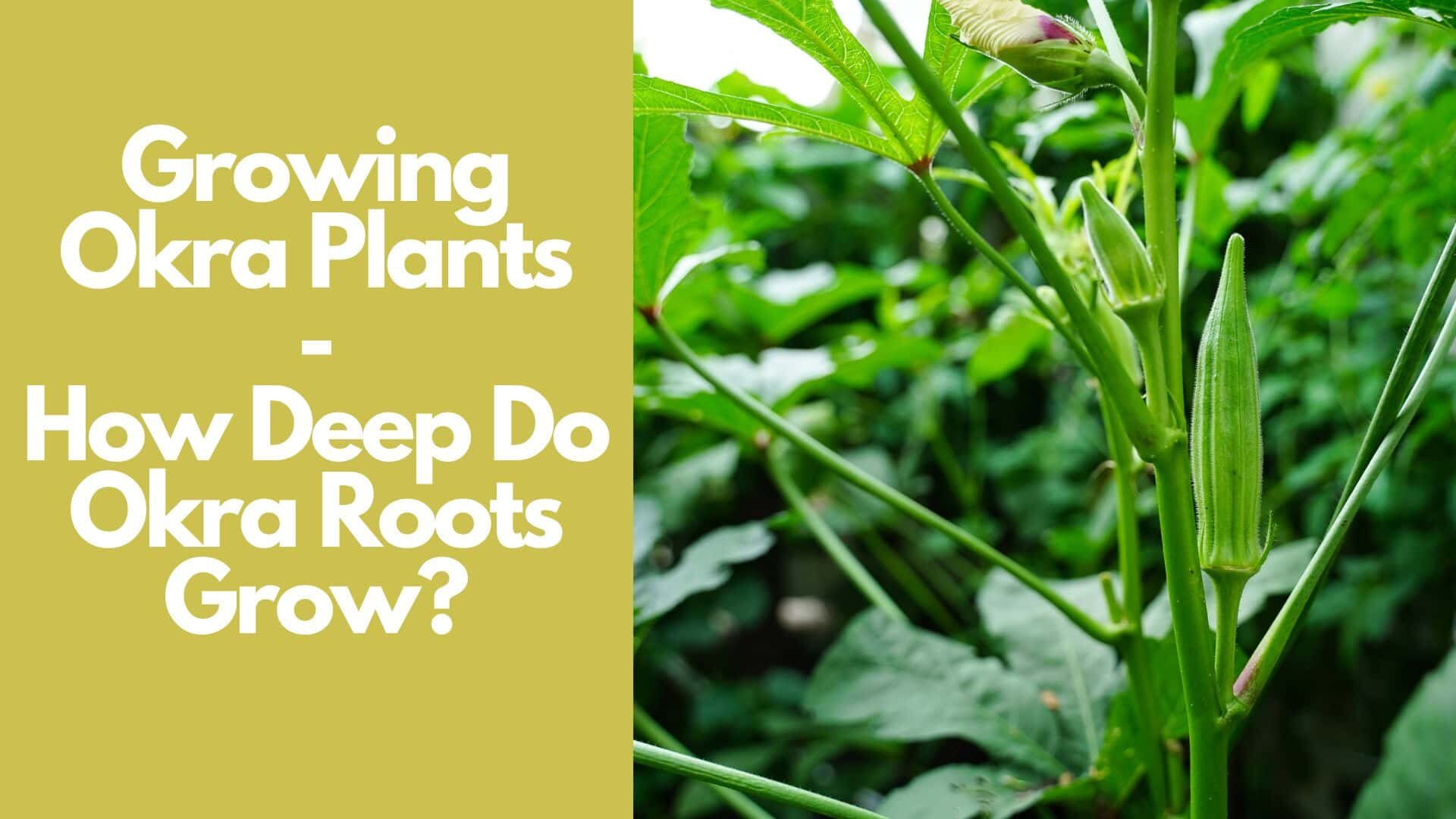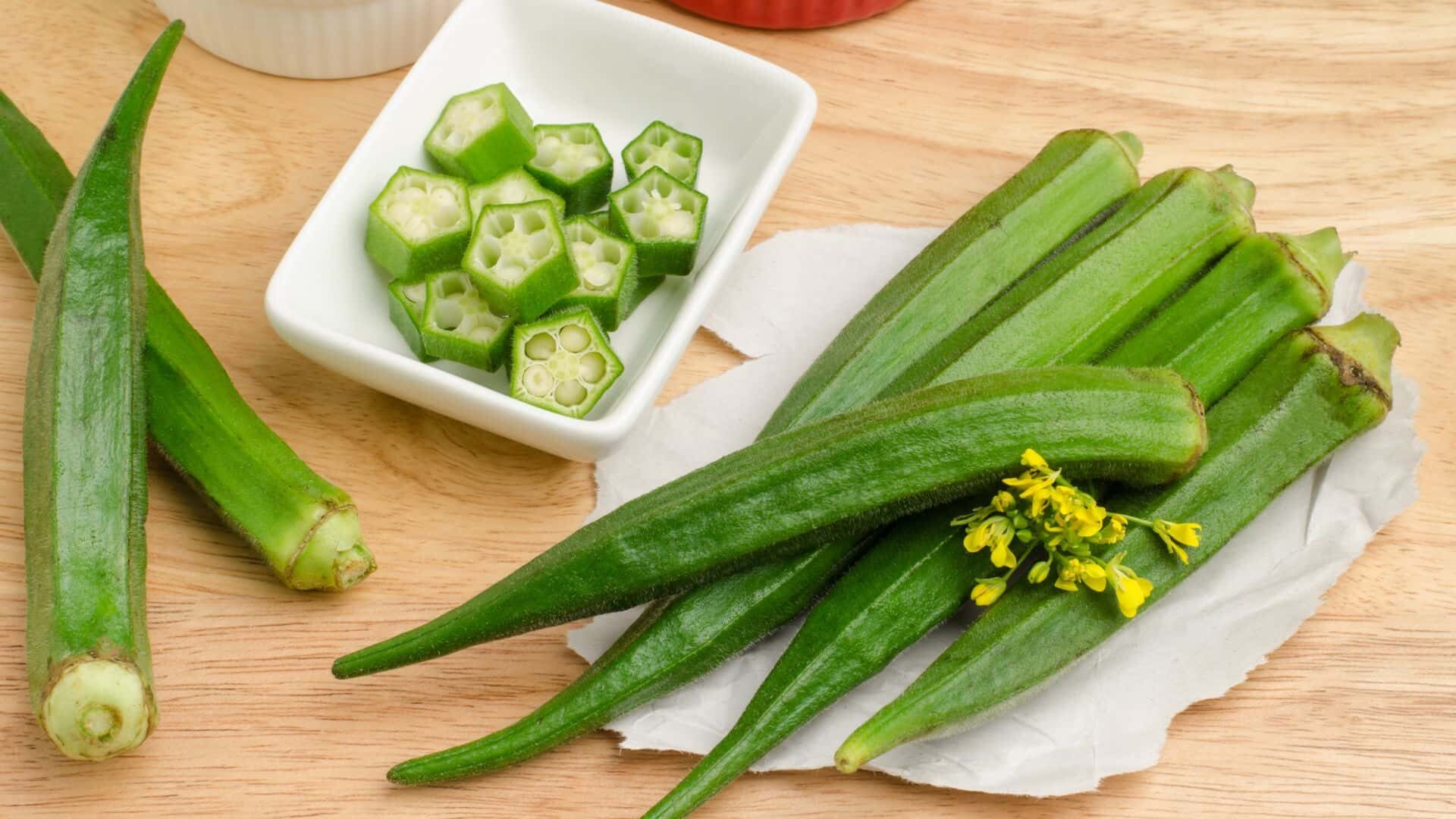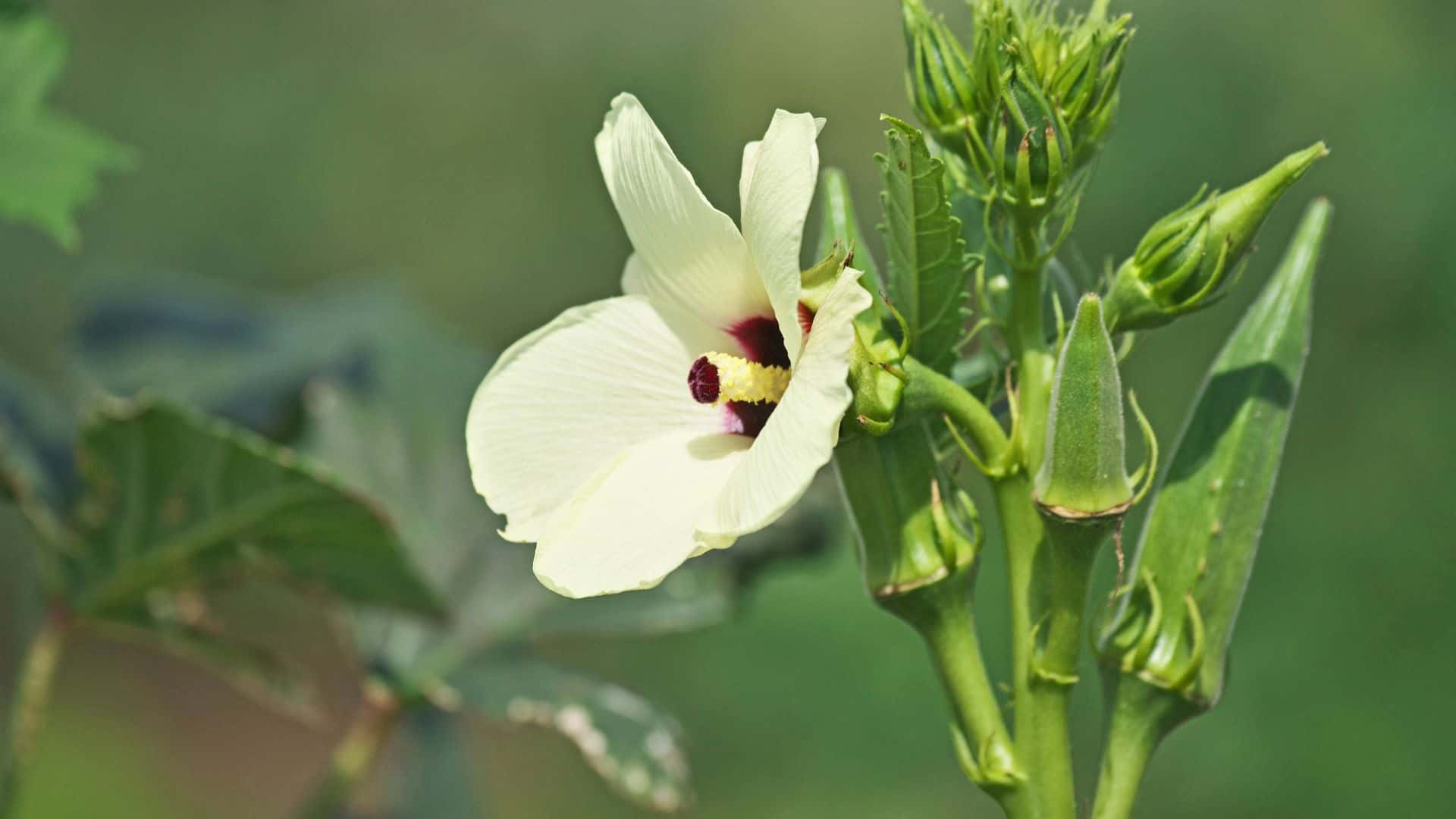A plant’s root system constantly supplies water and dissolved minerals to the stems and leaves. The roots must expand into new soil regions to accomplish it. Gardeners need to know how deep okra roots grow when it comes to okra planting.
Before we get into the question of how deep do okra roots grow, let’s first discuss the plant itself. Okra (Abelmoschus esculentus) is a blooming plant that is typically grown as an annual. But it grows as a perennial plant in dry, tropical climates. Okra’s eye-catching blossoms make it occasionally employed as a landscape plant. However, because of the delicious seed pods that develop after the flowers bloom, it is typically planted as a vegetable crop. These seed pods can use in various ways in the kitchen, but because of their sticky mucilage, they work particularly well for thickening stews.
There are five to seven lobes on the palmate leaves of the okra plant, and the flower heads are either yellow or white with a purple core. An elongated seed pod, measuring up to 7 inches in length, is filled with white seeds in a pentagon-shaped chamber.
Okra seeds can sow directly into the garden when the soil temperature reaches 65 to 70⁰F. Most often, it will take around two or three months for the plants to develop seed pods ready to be harvested. Seedlings can start indoors in biodegradable pots three to four weeks before the predicted frost date. When the roots of an okra plant are disturbed, the plant suffers. Roots play a major role for plants. By reading this guide, you will be able to know, How Deep Do Okra Roots Grow?.

Let’s start,
Why okra plants’ root health is essential?
In many respects, the roots are the lifeblood of your okra plants. Roots anchor plants to the ground if they are grown in soil. The plant’s stalks, stems, and leaves are the conduits through which it receives nutrition. Nutrients are the essential building components of all living things. There is no chlorophyll in a plant if it does not have them.
Think of your plant’s roots as suckers, sucking up nutrients from the soil. Plant growth ensures by nutrients such as phosphorus and potassium. Longer roots can extend deeper into a plant’s rhizosphere, allowing it to take advantage of all the nutrients present in the soil or hydro solution.
On the other hand, roots are more than just a source of nutrients. These organisms also alter the plant’s rhizosphere by producing chemicals that interact with the bacteria present in the environment and antibiotics that kill worms and parasites that can damage roots.
Aside from warding against disease, bacteria feed on dead root matter to grow and flourish in the secretions, which in turn helps them do their functions better. As a result, the plant’s ability to absorb nutrients improves.
Roots and beneficial bacteria form a symbiotic bond. Crops benefit from the presence of beneficial bacteria and fungus, which interact with one other.
You can’t grow healthy okra plants if you have unhealthy roots. In addition, helpful microorganisms, or nature’s invisible army, are a great way to ensure that roots are healthy. When a plant’s roots are dying or underperforming, or contaminated with a disease, the rest of the plant follows suit.
How does root depth affect the nearby soil?
Having healthy roots is essential to a plant’s health and well-being. They also return nutrients to the land. Soil fertility and long-term carbon storage improve with increased depth and breadth. During their active lives, roots recycle carbon and nutrients in the soil.
Do okra plants have deep roots?
Okra has a tap-root and support roots that can develop quite deep if supplied with large volumes of water infrequently or drip watering. Okra roots that penetrate deep into the soil can assist in maintaining a tall crop.
How deep do okra roots grow?
When planting okra, make sure the soil is well-prepared. When conditions are ideal, the roots can extend up to four feet below the soil’s surface. According to several sources, okra will grow in soils as low as 5.8 and as high as 7.5 pH. However, better conditions lead to higher yields, as well.
How to grow okra plants healthy?
The best place to start your okra seeds is on a warm, sunny window sill. Those who live in warmer climates can sow the seeds directly into the ground. Okra grows best in full sun; if you want it to bear fruit, plant it where it can take at least five hours of direct sunshine each day.
Soil with a PH of 6.5-7 is ideal for the plant’s growth. Checking the condition of your soil can be done either professionally or by yourself. If you don’t want to alter the pH of your soil, you can enrich it nutritionally by adding compost. Nutrients-rich soil rich is ideal for growing okra. Compost can use to improve the quality of your soil.
Okra seeds should be sown ½ inch deep, 7-8 inches apart, and 14 inches apart. Are they growing okra indoors and transplanting it later? Make sure you give yourself a 9- to 10-inch buffer between plants.
The seedlings are fragile and easily destroyed, so be careful when handling them. You should dig a hole big enough to hold all of the root balls at once. When planting a seed, make sure to cover the roots with soil thoroughly.
Thin the seedlings to a spacing of 18 to 24 inches when they reach a height of 3 inches. Summer is the best time to water your plants. If you live in a hot, dry climate, you may need to use more than the recommended one inch of water every week. Too much heat could slow the growth of okra.
When okra plants are about 5 to 6 feet tall, cut off the tops. As a result, there will be more branches. Remove any unwanted okra branches.
Some producers trim their plants to roughly 2 feet during the summer months to increase yields. As time goes on, the plants regrow, producing another okra harvest.

How to increase okra roots’ healthy?
Okra roots can improve using a few simple tricks. You can use these tricks to improve roots’ healthy.
1. Improve soil fertility
Okra grows best in soil with a lot of nutrients and drains well. They do better in water with a pH of about 6.5. However, even heavier soils can produce well, provided they drain well enough to prevent water logging, which is more common in loams and sandy loams. Okra thrives in free-standing raised soil beds if the soil drainage is less than ideal.
Your plants’ roots will flourish if you add an organic supplement to the surrounding soil.
2. Make space between plants
Rows should be 3 feet apart, with seeds sown 1 inch deep and 4 to 6 inches apart. A few inches after the seedlings have sprouted, thin the row, so the remaining plants are spaced 1.5 to 2 feet apart.
3. Watering
Okra plants require soil that is both evenly moist and only slightly damp. Watering your plants is essential. However, even in dry periods, Okra plants do best when watered once a week.
More water is required at the start of the flowering stage and throughout the entire process. Before you water, inspect the soil. There is no need to water if the soil is moist two inches down; nevertheless, you should water your plants if the soil is dry.
You only need to water your plants once a week, but do so thoroughly.
4. Humidity and Temperature
Okra is an important meal in hot climes where many other crops fail. It is common for the seed pods to be smaller in colder locations, but they are still quite tasty and nutritious. Okra plants thrive in warm climates.
At 80 degrees Fahrenheit, they begin to work and become considerably more powerful when the temperature rises to 90 degrees Fahrenheit. They do best in dry regions but can also thrive in humid ones.
5. Mulching
Mulching is usually a good idea to keep the soil from drying out. Mulching in areas with hot summers might lessen the amount of water you need to apply. Even though these plants can survive drought, keeping the soil a little moist for the best growth and yield is best.
5 Best Okra varieties to grow in the container
There are numerous varieties of okra to pick. The flavor is usually modest, although the length of the pod varies. Here are the top five container plants to grow.
1. Go Big
It’s impossible not to appreciate a plant that serves two purposes: providing tasty, edible fruit and being aesthetically pleasing. The Go Big okra is an excellent choice for gardeners who value aesthetics and function.
These plants can grow to heights of seven feet and a width of five feet. You can grow okra in containers if you have a large enough pot, but this type isn’t for you.
When fully mature, Go Big’s dark green pods are about seven inches long and can take up to 65 days to produce.
2. Baby Bubba Hybrid
‘Baby Bubba’ Hybrid’s modest stature and ability to grow in containers and small garden plots make it a popular choice.
Okra can grow up to 24 inches in diameter and are between 3 and 4 feet tall. In cold locations with shorter growing seasons, this cultivar’s dark green fruits can grow up to three inches long and mature in around 53 days.
3. Perkins Long Pod
This heirloom variety can be grown in northern and southern climes because it is an early variety. It takes about 55 days for it to achieve full maturity.
Plants growing up to five feet tall make straight green pods about four inches long.
4. Cajun Delight
With a maturation time of 50-55 days in milder areas, this hybrid is an excellent option for those with a limited growing season. Cajun Delight plants can reach a height of four feet at their highest point.
The dark green pods are between three and five inches long and somewhat curled.
5. Louisiana Green Velvet
“Louisiana Green Velvet” can grow to eight feet and produce dark green, spineless pods measuring eight inches across.
In addition to its impressive size, this fruit-bearing tree makes the best environmental visual statement. It takes roughly 65 days for plants to mature.
Watch 5 Successful tips to grow lots of okra | Video
Top 5 FAQs & answers related to How deep do okra roots grow
Can I grow okra in a 5-gallon bucket?
Select a pot at least 10 inches in diameter for the okra plant. You can use pots up to 10 inches in diameter from a garden center or 5-gallon buckets with a top diameter of 12 inches and a bottom diameter of 10 1/2 inches or more.
Do okra plants need full sun?
Okra grows best in direct sunlight. During flowering and pod formation, regular irrigation is essential. A thorough weekly soaking is helpful during prolonged dry periods. Diseases can control through crop rotation and careful soil management.
Which plants cannot plant near okra?
Cucumbers, melons, eggplants, and sweet or hot peppers are all included in this category. Growing cucumbers and okra together is a good idea because both plants thrive in moist, well-drained soil. Cucumber vines spread and require full sun to ripen, so don’t put them too close together.
How long does okra take to grow?
Okra grows and matures around 50 – 65 days. If the plants receive adequate sunlight, fertilizer, and water, they will continue producing pods. It implies more okra for you if you have a longer growing season!
What is the best fertilizer for okra?
Okra plants benefit significantly from compost tea. After transplanting, use the product once every two weeks in the garden. If you’re going to use compost tea to water your transplants, soak the leaves beforehand.
Conclusion
By reading this guide, I hope you got the full idea of How Deep Do Okra Roots Grow: Guide with 5 Okra Varieties.
Please share this How Deep Do Okra Roots Grow: Guide with 5 Okra Varieties with your friends and do a comment below about your feedback.
We will meet you on next article.
Until you can read, How to Remove Landscape Fabric: 5 Easy Steps Guide with Tips
